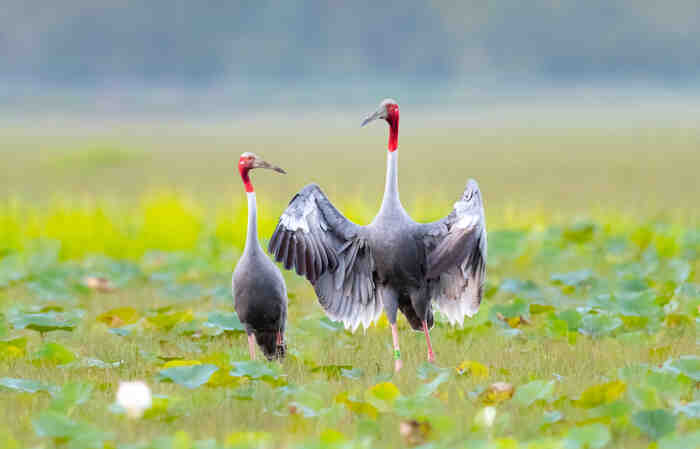Grus antigone
IUCN
LCBasic Information
Scientific classification
- name:Grus antigone
- Scientific Name:Grus antigone,Sarus Crane
- Outline:Wading birds
- Family:Gruiformes Grus
Vital signs
- length:140-152cm
- Weight:About 12kg
- lifetime:About 30-40 years
Feature
The head, throat and upper neck are bare and featherless, with rough, grainy skin and bright red in color.
Distribution and Habitat
Distributed in Australia, Cambodia, China, India, Lao People's Democratic Republic, Myanmar, Nepal, Pakistan, and Vietnam.
Extinct in: Malaysia, Philippines, Thailand.
Migrant bird: Bangladesh.
The Red-necked Crane is a resident bird, inhabiting open plain grasslands, swamps, lakeside shallows, and forest edge shrub swamps, and sometimes appears in farmland areas.
Appearance
The head, throat and upper neck are bare and featherless. The skin is rough and granular and bright red in color. This red color is more obvious during breeding. The top of the head is smooth and gray-green; there is a gray-white feather spot at the base of the mouth. There are some black bristles on the eyes, and there is sometimes a white collar at the base of the neck next to the exposed upper neck. The primary coverts and primary flight feathers are black, the inner secondary flight feathers and tertiary flight feathers are extended and cover the light gray tail feathers, and the rest of the body feathers are gray. The iris is orange, the mouth is gray or green, and the tarsometatarsus and toes are red or pink.
Size measurement: body length 1400-1523 mm; bill peak 172-182 mm; wings 600-675 mm; tail 255-263 mm; tarsus 310-355 mm.
Details
Sarus Crane is a large wading bird with three subspecies.

Sarus Crane often moves alone or in pairs or family groups. In autumn and winter, it sometimes gathers in large groups of dozens or even hundreds of individuals. It is timid and alert. They mainly feed on fish, frogs, shrimps, lizards, grains and aquatic plants. They often forage in pairs or family groups near water and in the fields, especially in the early morning and evening.
The call of the red-necked crane: a loud and persistent trumpet sound, usually in pairs day and night on the ground or in flight. When calling, the neck is straight and the beak is facing the sky.
The breeding season of the red-necked crane is from May to August. They nest in open plains and swamps with sparse trees or shrubs. The nest is made of dead branches and grass. Each nest lays 2 eggs, and occasionally 1 egg. The eggs are milky white with brown spots.
Since 1960, the swamp wetlands suitable for the nesting of the Sarus crane have been reclaimed as farmland, and the tropical rainforest and monsoon forest in the low mountain area near the Tianba area have been cut down to plant economic trees and crops such as rubber, causing the crane to lose its habitat. Indiscriminate hunting has caused the number of Sarus cranes to decline and they are on the verge of extinction.
Listed in the 2012 Red List of Endangered Species of the World Conservation Union (IUCN) ver 3.1 - Vulnerable (VU).
Listed as a Class II protected animal under the CITES Convention on International Trade in Endangered Species.
Listed in China's national key protection level: Level 1
Listed in China's Red Book of Endangered Animals: Rare
Protect wild animals and eliminate game.
Maintaining ecological balance is everyone's responsibility!








